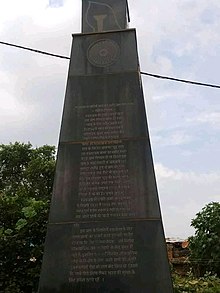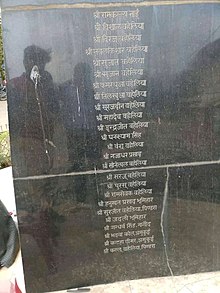Baheliya
The Baheliya are a Hindu caste found in the state of Uttar Pradesh, India.[1][2]

Baheliya community had a role in the 1857 independence struggle at Pindra Village, Satna, Madhya Pradesh wherein they fought bravely against the Britishers and were killed.[3] The names of the martyrs are mentioned on the memorial present at the village.[4]

Baheliya community has a long history of being a source of manpower in India.[5] They were footsoldiers in various armies. They were also appointed as Governors under the Mughals. During the reign of Tuglaqs in Delhi in the 14th century, a certain Sanidhi, an African and a Baheliya were appointed as joint governor with the title of hazari, at the fort of Chunar on the bank of Ganga near Benaras. A jagir of 27 villages were conferred on them.[6]
During the Seventeenth century they were conspicuous as footsoldiers fighting under Mughal commanders. Mirza Nathan mention them as serving in Bengal in 1692,[7] the Mughal fauzdar of Kanchipuram in South India had many Baheliya in his service who went over to Marathas after a battle. In 1700, hundred of Baheliya footmen were killed as a result of ill-timed explosion during the seize of Satara by Aurangzeb, the survivors enraged at the carelessness of their Mughal Commanders set fire to the seize batteries as a substitute for the proper cremation of their brother, Sons and friends. [8]
Origin
They are a tribal community of hunters and bird catchers, and the origin of their name is from the Sanskrit vyadka, meaning one who pierces. They are mainly involved in bird catching, extracting honey from beehives and picking peacock feathers for the manufacture of fans.[1]
Present circumstances
Traditionally the Baheliya economic activity revolved around bird catching and selling honey. In addition, their main economic activity remains manufacturing fans from peacock feathers. These fans are then sold to Bania middlemen, who sell them on in cities such as Kolkata and Delhi Each of their settlement contains an informal caste council, known as a biradari panchayat. This consist of five members who are elected by community members. The panchayat acts as instrument of social control, dealing with issues such as divorce and adultery.[1]
The 2011 Census of India for Uttar Pradesh showed the Baheliya population as 143,442.[9]
References
- People of India Uttar Pradesh Volume XLII Part One edited by A Hasan & J C Das pages 112 to 116 Manohar Publications
- People of India Hayana Volume XXIII edited by M.L Sharma and A.K Bhatia pages 122 to 125 Manohar
- https://zeenews.india.com/hindi/india/bihar-jharkhand/people-of-pindra-of-mp-gave-tough-fight-to-britishers-in-1857-revolt/562601 retrieved on 4. 08. 2020
- https://www.dnaindia.com/india/report-india-s-independence-struggle-built-on-the-backs-of-forgotten-bravehearts-2781905 retrieved on 04.08.2020
- Naukar, Rajput and Sepoy, D.H.A.Kolff (1990), 117.
- Mirzapur Gazetteer 307. Crooke Tribes and Caste, 1,105. See also Thomas Chronicles, 196
- Mirza Nathan,Baharistan-i-Gahyabi,I,189 and,II, 826
- Bhimsen Tarikh-I-Dilkasha,186,222
- "A-10 Individual Scheduled Caste Primary Census Abstract Data and its Appendix - Uttar Pradesh". Registrar General & Census Commissioner, India. Retrieved 4 February 2017.